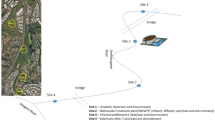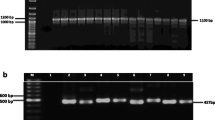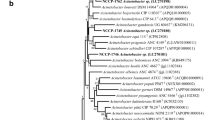Abstract
The present study explored the association between multiple antibiotic resistance (MAR) index and virulence index to determine what percent of environmental antibiotic-resistant (eARB) bacteria could pose threat as potential pathogen. 16srRNA-based sequencing of 113 non-duplicate isolates identified majority of them to be gram negative belonging to Enterobacter, Pseudomonas, Aeromonas, Proteus, Acinetobacter, and Klebsiella. Statistical comparison of MAR indices of the abovementioned genera indicated differences in the median values among the groups (p < 0.001). Pair-wise multiple comparison by Dunn’s method indicated significant difference in MAR indices (p < 0.05), based on which multiple antibiotic resistance phenotype could be ranked in the order Pseudomonas > Klebsiella = Acinetobacter > Proteus > Aeromonas > Enterobacter. Association between MAR index and virulence index revealed that 25% of isolates in the population under study posed high threat to human/animal or both; out of which 75% isolates belonged to genus Pseudomonas. Based on observations of comparative analysis of the six gram-negative genera, it could be concluded that Pseudomonas isolates from environment pose significantly high threat as potential pathogens while Enterobacter isolates posed no threat.





Similar content being viewed by others
References
Abraham, W. R. (2011). Megacities as sources for pathogenic bacteria in rivers and their fate downstream. Int J Microbiol. doi:10.1155/2011/798292.
Adefisoye, M. A., & Okoh, A. I. (2016). Identification and antimicrobial resistance prevalence of pathogenic Escherichia coli strains from treated wastewater effluents in eastern cape, South Africa. Microbiology, 5, 143–151.
Alexander, J., Bollmann, A., Seitz, W., & Schwartz, T. (2015). Microbiological characterization of aquatic microbiomes targeting taxonomical marker genes and antibiotic resistance genes of opportunistic bacteria. Sci Total Environ, 512-513, 316–325.
Aminov, R. I. (2009). The role of antibiotics and antibiotic resistance in nature. Environmental Microbiology, 11, 2970–2988.
Ashbolt, N. J., Amézquita, A., Backhaus, T., Borriello, P., Brandt, K. K., Collignon, P., Coors, A., Finley, R., Gaze, W. H., Heberer, T., Lawrence, J. R., Larsson, D. G., McEwen, S. A., Ryan, J. J., Schönfeld, J., Silley, P., Snape, J. R., Van den Eede, C., & Topp, E. (2013). Human health risk assessment (HHRA) for environmental development and transfer of antibiotic resistance. Environ Health Persp, 121, 993–1001.
Bauer, A. W., Kirby, W. M., Sherris, J. C., & Turck, M. (1966). Antibiotic susceptibility testing by a standardized single disk method. American Journal of Clinical Pathology, 45, 493–496.
Berendonk, T. U., Manaia, C. M., Merlin, C., Fatta-Kassinos, D., Cytryn, E., Walsh, F., Bürgmann, H., Sørum, H., Norström, M., Pons, M. N., Kreuzinger, N., Huovinen, P., Stefani, S., Schwartz, T., Kisand, V., Baquero, F., & Martinez, J. L. (2015). Tackling antibiotic resistance: the environmental framework. Nature Reviews. Microbiology, 13, 310–317. doi:10.1038/nrmicro3439.
Berezin, E. N., & Solórzano, F. (2014). Gram-negative infections in pediatric and neonatal intensive care units of Latin America. Journal of Infection in Developing Countries, 8, 942–953.
Billing, E., & Luckhurst, E. R. (1957). A simplified method for the preparation of egg yolk media. Journal of Applied Microbiology. doi:10.1111/j.1365-2672.1957.tb04523.x.
Boucher, H. W., Talbot, G. H., Bradley, J. S., Edwards, J. E., Gilbert, D., Rice, L. B., Scheld, M., Spellberg, B., & Bartlett, J. (2009). Bad bugs, no drugs: No ESKAPE! An update from the Infectious Diseases Society of America. Clinical Infectious Diseases, 48, 1–12. doi:10.1086/595011.
Clinical and Laboratory Standards Institute. (2007). Performance standards for antimicrobial susceptibility testing. Seventeenth informational supplement M100-S17 (ISBN 1-56238-625-5). Wayne, Pennsylvania: Clinical and Laboratory Standards Institute.
Coutinho, F. H., Silveira, C. B., Pinto, L. H., Salloto, G. R., Cardoso, A. M., Martins, O. B., Vieira, R. P., & Clementino, M. M. (2014). Antibiotic resistance is widespread in urban aquatic environments of Rio de Janeiro, Brazil. Microbial Ecology, 68, 441–452.
Czekalski, N., Gascón Díez, E., & Bürgmann, H. (2014). Wastewater as a point source of antibiotic-resistance genes in the sediment of a freshwater lake. The ISME Journal, 8, 1381–1390.
Czekalski, N., Sigdel, R., Birtel, J., Matthews, B., & Bürgmann, H. (2015). Does human activity impact the natural antibiotic resistance background? Abundance of antibiotic resistance genes in 21 Swiss lakes. Environment, 81, 45–55.
Dantas, G., Sommer, M. O., Oluwasegun, R. D., & Church, G. M. (2008). Bacteria subsisting on antibiotics. Science, 320, 100–103. doi:10.1126/science.1155157.
Davis, R., & Brown, P. D. (2016). Multiple antibiotic resistance index, fitness and virulence potential in respiratory Pseudomonas aeruginosa from Jamaica. Journal of Medical Microbiology, 65, 261–271. doi:10.1099/jmm.0.000229.
Drudge, C. N., Elliott, A. V., Plach, J. M., Ejim, L. J., Wright, G. D., Droppo, I. G., & Warren, L. A. (2012). Diversity of integron- and culture-associated antibiotic resistance genes in freshwater floc. Applied and Environmental Microbiology, 78, 4367–4372.
Finley, R. L., Collignon, P., Larsson, D. G., McEwen, S. A., Li, X. Z., Gaze, W. H., Reid-Smith, R., Timinouni, M., Graham, D. W., & Topp, E. (2013). The scourge of antibiotic resistance: the important role of the environment. Clinical Infectious Diseases, 57, 704–710.
Ganguly, N. K., Arora, N. K., Chandy, S. J., Fairoze, M. N., Gill, J. P., Gupta, U., Hossain, S., Joglekar, S., Joshi, P. C., Kakkar, M., Kotwani, A., Rattan, A., Sudarshan, H., Thomas, K., Wattal, C., Easton, A., Laxminarayan, R., & Global Antibiotic Resistance Partnership (GARP) - India Working Group. (2011). Rationalizing antibiotic use to limit antibiotic resistance in India. The Indian Journal of Medical Research, 134, 281–294.
Gootz, T. D. (2010). The global problem of antibiotic resistance. Critical Reviews in Immunology, 30, 79–93.
Grosso-Becerra, M. V., Santos-Medellín, C., González-Valdez, A., Méndez, J. L., Delgado, G., Morales-Espinosa, R., Servín-González, L., Alcaraz, L. D., & Soberón-Chávez, G. (2014). Pseudomonas aeruginosa clinical and environmental isolates constitute a single population with high phenotypic diversity. BMC Genomics, 28, 15–318. doi:10.1186/1471-2164-15-318.
Gullberg, E., Cao, S., Berg, O. G., Ilbäck, C., Sandegren, L., Hughes, D., & Andersson, D. I. (2011). Selection of resistant bacteria at very low antibiotic concentrations. PLoS Pathogens, 2011, e1002158. doi:10.1371/journal.ppat.1002158.
Hennequin, C., & Forestier, C. (2009). oxyR, a LysR-type regulator involved in Klebsiella pneumoniae mucosal and abiotic colonization. Infection and Immunity, 77, 5449–5457.
Kaplan, J. E., Roselle, G., & Sepkowitz, K. (1998). Opportunistic infections in immunodeficient populations. Emerging Infectious Diseases, 4, 421–422.
Krumperman, P. H. (1983). Multiple antibiotic resistance indexing of Escherichia coli to identify high-risk sources of fecal contamination of foods. Applied and Environmental Microbiology, 46, 165–170.
Marti, E., Variatza, E., & Balcazar, J. L. (2014). The role of aquatic ecosystems as reservoirs of antibiotic resistance. Trends in Microbiology, 22, 36–41.
Martínez, J. L. (2008). Antibiotics and antibiotic resistance genes in natural environments. Science, 321, 365–367.
Martínez, J. L. (2014). Short-sighted evolution of bacterial opportunistic pathogens with an environmental origin. Frontiers in Microbiology. doi:10.3389/fmicb.2014.00239.
Martínez, J. L., & Baquero, F. (2002). Interactions among strategies associated with bacterial infection: pathogenicity, epidemicity and antibiotic resistance. Clinical Microbiology Reviews, 15, 647–679.
Martins, V. V., Pitondo-Silva, A., Manço Lde, M., Falcão, J. P., Freitas Sdos, S., & da-Silveira, W.D., & Stehling, E.G. (2014). Pathogenic potential and genetic diversity of environmental and clinical isolates of Pseudomonas aeruginosa. APMIS, 122(2), 92–100. doi:10.1111/apm.12112.
Oberlé, K., Capdeville, M. J., Berthe, T., Budzinski, H., & Petit, F. (2012). Evidence for a complex relationship between antibiotics and antibiotic-resistant Escherichia coli: from medical center patients to a receiving environment. Environmental Science & Technology, 46, 1859–1868.
Okeke, I. N., & Edelman, R. (2001). Dissemination of antibiotic-resistant bacteria across geographic borders. Clinical Infectious Diseases, 33, 364–369.
Raghunath, D. (2008). Emerging antibiotic resistance in bacteria with special reference to India. Journal of Biosciences, 33, 593–603.
Rice, L. B. (2010). Progress and challenges in implementing the research on ESKAPE pathogens. Infect Control Hosp Epidemiol, 31(Suppl 1), 7–10.
Rizzo, L., Manaia, C., Merlin, C., Schwartz, T., Dagot, C., Ploy, M. C., Michael, I., & Fatta-Kassinos, D. (2013). Urban wastewater treatment plants as hotspots for antibiotic resistant bacteria and genes spread into the environment: a review. Sci Total Environ, 447, 345–360.
da Silva, G. J., & Mendonça, N. (2012). Association between antimicrobial resistance and virulence in Escherichia coli. Virulence, 3(1), 18–28. doi:10.4161/viru.3.1.18382.
Sood, S., & Gupta, R. (2012). Antibiotic resistance pattern of community acquired uropathogens at a tertiary care hospital in Jaipur, Rajasthan. Indian Journal of Community Medicine, 37(1), 39–44.
Stepanovic, S., Vukovic, D., Dakic, I., Savic, B., & Svabic-Vlahovic, M. (2000). A modified microtiter-plate test for quantification of Staphylococcal biofilm formation. Journal of Microbiological Methods, 40, 175–179.
Talukdar, P. K., Rahman, M., Rahman, M., Nabi, A., Islam, Z., Hoque, M. M., Endtz, H. P., & Islam, M. A. (2013). Antimicrobial resistance, virulence factors and genetic diversity of Escherichia coli isolates from household water supply in Dhaka, Bangladesh. PloS One, 8(4), e61090. doi:10.1371/journal.pone.0061090.
Taylor, N. G. H., Verner-Jeffreys, D. W., & Baker-Austin, C. (2011). Aquatic systems: maintaining, mixing and mobilising antimicrobial resistance? Trends in Ecology & Evolution, 26, 278–284.
Vlieghe, E., Bal, E. M., & Gould, I. M. (2010). Surveillance of antibiotic resistance in developing countries: needs, constraints and realities. In A. J. Sosa et al. (Eds.), Antimicrobial resistance in developing countries (pp. 463–475). Berlin: Springer.
WHO (World Health Organization), (2014). Antimicrobial resistance: global report on surveillance. Available online. http://www.who.int/drugresistance/documents/surveillancereport/en/. (accessed May 2015).
Wojnicz, D., & Jankowski, S. (2007). Effects of subinhibitory concentrations of amikacin and ciprofloxacin on the hydrophobicity and adherence to epithelial cells of uropathogenic Escherichia coli strains. International Journal of Antimicrobial Agents, 29, 700–704.
Xiong, W., Sun, Y., Ding, X., Wang, M., & Zeng, Z. (2015). Selective pressure of antibiotics on ARGs and bacterial communities in manure-polluted freshwater-sediment microcosms. Frontiers in Microbiology, 11, 6:194. doi:10.3389/fmicb.2015.00194.
Zurfluh, K., Hächler, H., Nüesch-Inderbinen, M., & Stephan, R. (2013). Characteristics of extended-spectrum β-lactamase- and carbapenemase-producing Enterobacteriaceae isolates from rivers and lakes in Switzerland. Applied and Environmental Microbiology, 79, 3021–3026.
Acknowledgements
This work was supported by intramural funds from DAE to National Institute of Science Education and Research. SKS and RE are grateful to DAE for financial support in the form of fellowship. MM acknowledges financial support from DST INSPIRE in the form of fellowship. The study design was conceived and planned by HM and executed by SKS, RE, and MM. Authors SKS and RE have equal contribution. The authors declare no conflict of interest.
Author information
Authors and Affiliations
Corresponding author
Electronic supplementary material
ESM 1
(DOCX 1309 kb)
Rights and permissions
About this article
Cite this article
Singh, S.K., Ekka, R., Mishra, M. et al. Association study of multiple antibiotic resistance and virulence: a strategy to assess the extent of risk posed by bacterial population in aquatic environment. Environ Monit Assess 189, 320 (2017). https://doi.org/10.1007/s10661-017-6005-4
Received:
Accepted:
Published:
DOI: https://doi.org/10.1007/s10661-017-6005-4




